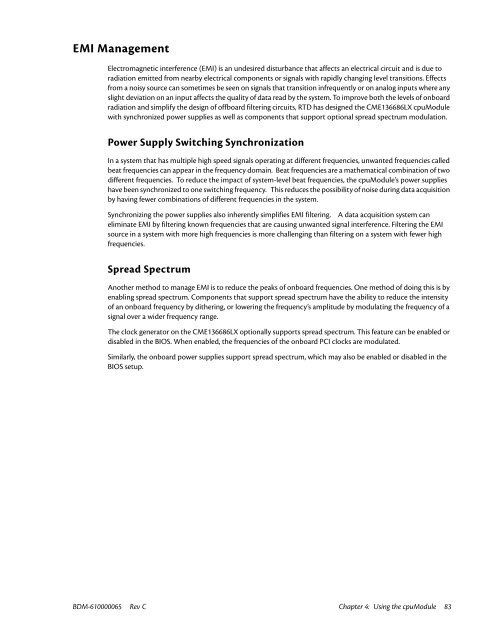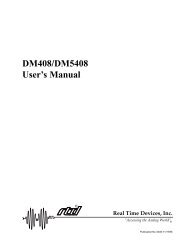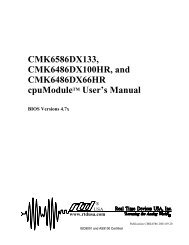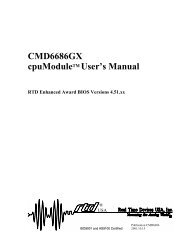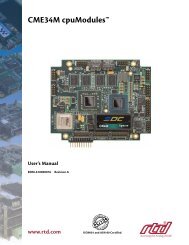CME136686LX Hardware Manual - RTD Embedded Technologies ...
CME136686LX Hardware Manual - RTD Embedded Technologies ...
CME136686LX Hardware Manual - RTD Embedded Technologies ...
Create successful ePaper yourself
Turn your PDF publications into a flip-book with our unique Google optimized e-Paper software.
EMI Management<br />
Electromagnetic interference (EMI) is an undesired disturbance that affects an electrical circuit and is due to<br />
radiation emitted from nearby electrical components or signals with rapidly changing level transitions. Effects<br />
from a noisy source can sometimes be seen on signals that transition infrequently or on analog inputs where any<br />
slight deviation on an input affects the quality of data read by the system. To improve both the levels of onboard<br />
radiation and simplify the design of offboard filtering circuits, <strong>RTD</strong> has designed the <strong>CME136686LX</strong> cpuModule<br />
with synchronized power supplies as well as components that support optional spread spectrum modulation.<br />
Power Supply Switching Synchronization<br />
In a system that has multiple high speed signals operating at different frequencies, unwanted frequencies called<br />
beat frequencies can appear in the frequency domain. Beat frequencies are a mathematical combination of two<br />
different frequencies. To reduce the impact of system-level beat frequencies, the cpuModule's power supplies<br />
have been synchronized to one switching frequency. This reduces the possibility of noise during data acquisition<br />
by having fewer combinations of different frequencies in the system.<br />
Synchronizing the power supplies also inherently simplifies EMI filtering. A data acquisition system can<br />
eliminate EMI by filtering known frequencies that are causing unwanted signal interference. Filtering the EMI<br />
source in a system with more high frequencies is more challenging than filtering on a system with fewer high<br />
frequencies.<br />
Spread Spectrum<br />
Another method to manage EMI is to reduce the peaks of onboard frequencies. One method of doing this is by<br />
enabling spread spectrum. Components that support spread spectrum have the ability to reduce the intensity<br />
of an onboard frequency by dithering, or lowering the frequency’s amplitude by modulating the frequency of a<br />
signal over a wider frequency range.<br />
The clock generator on the <strong>CME136686LX</strong> optionally supports spread spectrum. This feature can be enabled or<br />
disabled in the BIOS. When enabled, the frequencies of the onboard PCI clocks are modulated.<br />
Similarly, the onboard power supplies support spread spectrum, which may also be enabled or disabled in the<br />
BIOS setup.<br />
BDM-610000065 Rev C Chapter 4: Using the cpuModule 83


